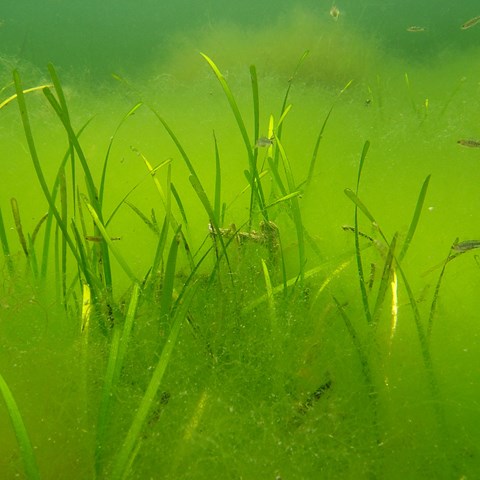Predatory fish can reduce eutrophication effects

Management measures that favour predatory fish, for example cod, can decrease eutrophication effects in coastal areas. This is the main conclusion of a new study reviewing over 50 experimental studies in the North Atlantic, being published in the Journal of Applied Ecology.
Large predatory fish have an important function in the coastal ecosystem by controlling the abundance of smaller fish and crabs, which indirectly can have a significant impact on vegetation. In shallow coastal areas large habitat-forming vegetation, such as eelgrass and bladderwrack, have been declining in the last decades. These species, in turn, constitute important habitats for many marine organisms and act as nursery areas for many fish species.
Increased nutrient levels in the water, i.e. eutrophication, is one important cause of the decline, because large habitat-forming vegetation suffers from overgrowth by fast-growing ephemeral, often filamentous algae. It has been suggested that also overfishing of large predatory fish, such as cod, may have caused a so-called trophic cascade in the coastal food web. This cascade consists of an increase in small fish and crabs, whereby their prey, herbivorous invertebrates, have declined, resulting in more blooms of filamentous algae.
Researchers at the Swedish University of Agricultural Sciences, Stockholm University, University of Gothenburg, and University of Groningen in the Netherlands have now systematically reviewed over 50 experiments conducted in the North Atlantic that have manipulated nutrient levels, abundance of invertebrate herbivores and different types of fish, to estimate how nutrients and coastal animals affect fast-growing ephemeral algae.
The results show that nutrients, mainly nitrogen, and predation from crabs and small fish on herbivorous invertebrates have similar positive effects on the growth of ephemeral algae. Small fishes and crabs have increased in the coastal zone as a result of overfishing of large predatory fish that normally eat and control them. The implication is that weak stocks of predatory fish can have similar effects on blooms of filamentous algae as eutrophication.
The results also show that there are synergistic effects of overfishing and eutrophication, such that their combined effect on ephemeral algae is larger than the sum of their individual effects. A conclusion of this study is that measures favouring large predatory fish or reducing small fish and crabs could relatively quickly reduce the abundance of ephemeral algae and thereby benefit eelgrass and bladderwrack. Thus, a more natural fish community can contribute to both better water quality and healthier habitats in coastal areas, which highlights the advantages of an integrated, ecosystem-based management of coastal areas.
Contact persons
Swedish University of Agricultural Sciences:
Örjan Östman, tel +46 10-478 41 53, orjan.ostman@slu.se
Ulf Bergström, tel +46 10-478 41 17, ulf.bergstrom@slu.se
Stockholm University:
Johan Eklöf, tel 08-16 13 58, johan.eklof@su.se
University of Gothenburg:
Per-Olav Moksnes, tel 031-786 27 10, per.moksnes@marine.gu.se
University of Groningen:
Klemens Eriksson, tel +31 50 363 2098, b.d.h.k.eriksson@rug.nl
The article
Top-down control as important as nutrient enrichment for eutrophication effects in North Atlantic coastal ecosystems. Örjan Östman, Johan Eklöf, Britas Klemens Eriksson, Jens Olsson, Per-Olav Moksnes & Ulf Bergström. Journal of Applied Ecology 2016. DOI: 10.1111/1365-2664.12654 http://onlinelibrary.wiley.com/doi/10.1111/1365-2664.12654/abstract
Press images (may be published without charge in articles about these findings, please acknowledge the photographer).
- Ephemeral algae in eelgrass. Photo: Per-Olav Moksnes, GU
- Mesopredators and ephemeral algae. Photo: Ulf Bergström, SLU